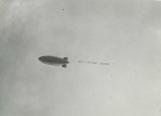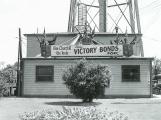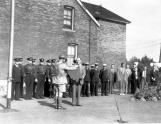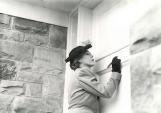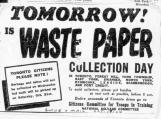1
The onset of World War II relieved the unemployment problem. Local men enlisted in the military, while women took their places in industries at home.Rationing limited many domestic products such as sugar, meat, coffee, and tea, as well as liquor and gasoline.
3
However, there were unanticipated outcomes to the booming war economy. Significant increases in vandalism were attributed to the improper supervision of children caused by wartime conditions.In East York, supervised recreational facilities were opened to provide alternative activities for children. Day care units were also created for pre-schoolers whose mothers were involved in wartime industries.
5
At home, Canadians were encouraged to help the war effort through a number of fundraising projects. In East York, as in other communities, Victory Bonds were sold.Canadians raised a total of $12 billion during the course of World War 11 through the sales of Victory Bonds.
7
Recruitment events to encourage enlistment were held in East York.This serviceman is likely an officer of the Toronto Garrison. He wears Khaki Drill (KD) cotton service dress authorized for wear in Canada during the summer months. National insignia is not evident as prior to 1942 the "CANADA" insignia was restricted to troops serving overseas.
The serviceman's leg wraps are tied in mounted troop or cavalry fashion with the twill fastening tapes tied at the ankles. They are wrapped from the top down as opposed to the infantry convention of wrapping from the ankle up. Because of this unique feature, the serviceman could be an officer of the Governor General's Horse Guards or Royal Canadian Dragoons.
9
The Mary Pickford House was an East York "War Funds" project. The bungalow, valued at $15,000, was built in 1943 at 90 Glenwood Crescent. Tickets were sold at $1.00 throughout the city to raise funds for war charities.Mary Pickford, the popular film star, was born in Toronto and helped develop plans for the project. She contributed the funds from the sale of her Toronto property to finance the bungalow.
Proceeds from the ticket sales were designated to the Lions British Child War Victims' Fund, the Evening Telegram British War Victims' Fund and the Malta Relief Fund Society of Toronto.
11
Canadian General Electric Company equipped the bungalow with the newest electrical appliances, including an electric stove, refrigerator, washer, coffee maker, toaster, iron, three radios, two telechron clocks, and a vacuum cleaner.Mary Pickford's appearance at the official opening of the home on May 26, 1943 ensured great publicity for the project.
